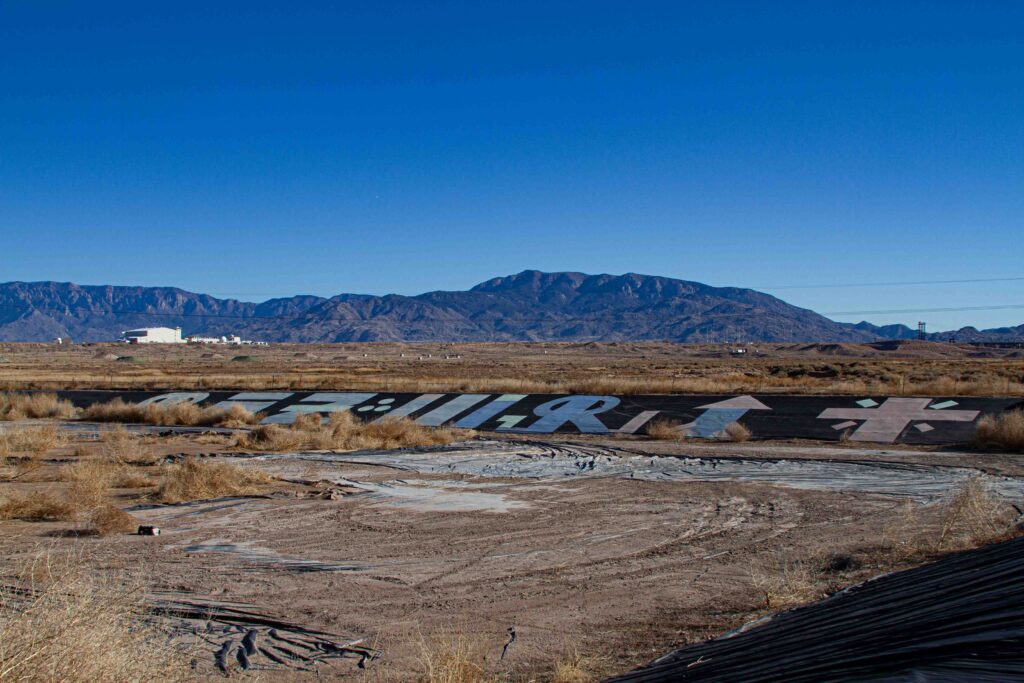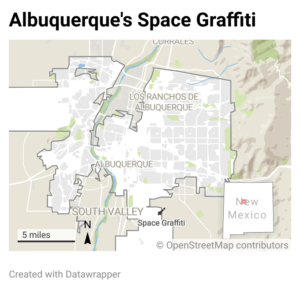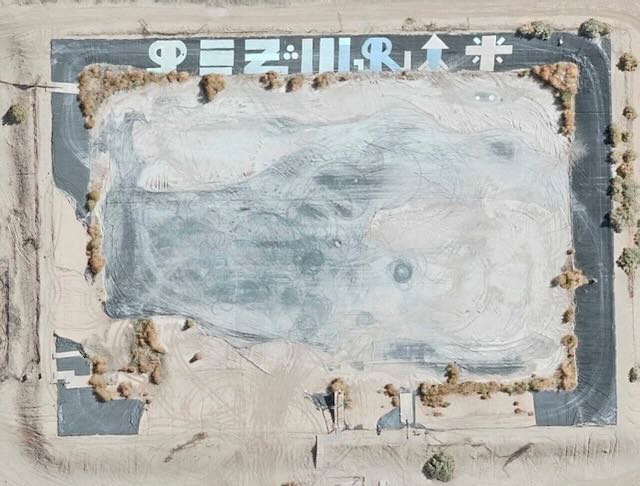
Space Graffiti. Photo by John Fleck, January 2025
And out of the ground the lord God formed every beast of the field, and every fowl of the air; and brought them unto Adam to see what he would call them: and whatsoever Adam called every living creature, that was the name thereof.
– Genesis 2-19 (King James)
When I was a youngster experimenting with being a writer, I worked on a short story (never finished it, I was never very good at making stuff up) about naming things. The character was socially awkward, lived in a scrabbly desert town on the outskirts of L.A., settled like drift on the edge of an arroyo left behind by the summer rains. He lived in a trailer and spent his time learning the names of birds.
 For Sunday’s bike ride we walked, or maybe hiked is the right word, across the marvelously dystopian frisbee golf course (disc golf course?) along Tijeras Arroyo on Albuquerque’s south side. The Brent Baca Memorial Disc Golf Course is stripped of the manicured aesthetic of golf golf (the kind with clubs and balls) – the Baca has graffiti and skulls on the top of poles and such.
For Sunday’s bike ride we walked, or maybe hiked is the right word, across the marvelously dystopian frisbee golf course (disc golf course?) along Tijeras Arroyo on Albuquerque’s south side. The Brent Baca Memorial Disc Golf Course is stripped of the manicured aesthetic of golf golf (the kind with clubs and balls) – the Baca has graffiti and skulls on the top of poles and such.
This stretch of Tijeras Arroyo is an urban castoff. Back in the 1930s, the old maps show a road running south of town, across the undeveloped mesa to Hicks Dairy, which advertised tuberculosis-free cows. A combination of a World War, a Cold War, and the growth of air travel covered the mesa with an airfield and a lot of barbed wire, and Tijeras Arroyo became a stranded leftover scrap of urban fabric barely accessible via a circuitous road named after Albuquerque’s most famous boxer. There was a jail there for a while (notably site of the vaguely infamous “Slippery 7 Escape” on New Year’s day, 1970), and some sewage sludge. Today there’s a shooting range and the “Montessa Park Convenience Center,” which is a particularly inconvenient place to haul a trailer full of trash.
It would be ridiculous to try to explain why we were out there on a freezing January Sunday morning, other than that it seemed too cold to ride and “hiking” presented itself as a better option.
A young friend hipped me to the idea of “urban exploring” as a thing with a name, and as I mentioned above, I have long been entranced with the power God gave us (my atheism notwithstanding) to name things. One of the premises of our urban exploring is that no place is uninteresting, but in the hierarchy of interesting, the raggedy bits are the best – alleys and flood control channels, the circumnavigation of junkyards, the perimeter fences of the military industrial complex. Places of graffiti.
Tijeras Arroyo is delightfully raggedy.
In preparing for Sunday’s outing, I had occasion to spot this in the satellite map imagery:

Space graffiti, as seen from space.
The artists’ canvas here is the sloped plastic sides of an old sewage lagoon, about the size of a football field (take your pick of footballs, this isn’t science). It’s maybe from the old jail, or a relic of the city sewage sludge disposal operation.
On Language
Conversation with my (h/b)iking buddy landed on Roland Barthes “The Death of the Author,” about the role of the intention of the author in literary criticism. We’re not as highbrow as it sounds, but the point of these outings in part is to make sense of the world by being in it and talking about it, and I’ve been entranced lately with the gap between graffiti’s meaning and intention, and how I as an enthusiastic audience member take it in.
No right answers here. My (h/b)inking interlocutor made patiently clear that I was over-interpreting Barthes’ intent, which is kinda meta. I can see a rocket ship and a pretty enthusiastic cross in the space graffiti, but now I’m afraid to even consider whether I’m supposed to be trying to tease out the artists’ intent or just take in the piece, bringing my “urban explorer” mindset to the experience.
It was way too cold to have biked, but at the pace of walking under a winter sun it was lovely.

Your typo in the second paragraph of On Language yields a delightful. …hinking/binking/inking rhythm that fits perfectly with the theme of “urban exploring” in the raggedy bits. Thanks for the tour!